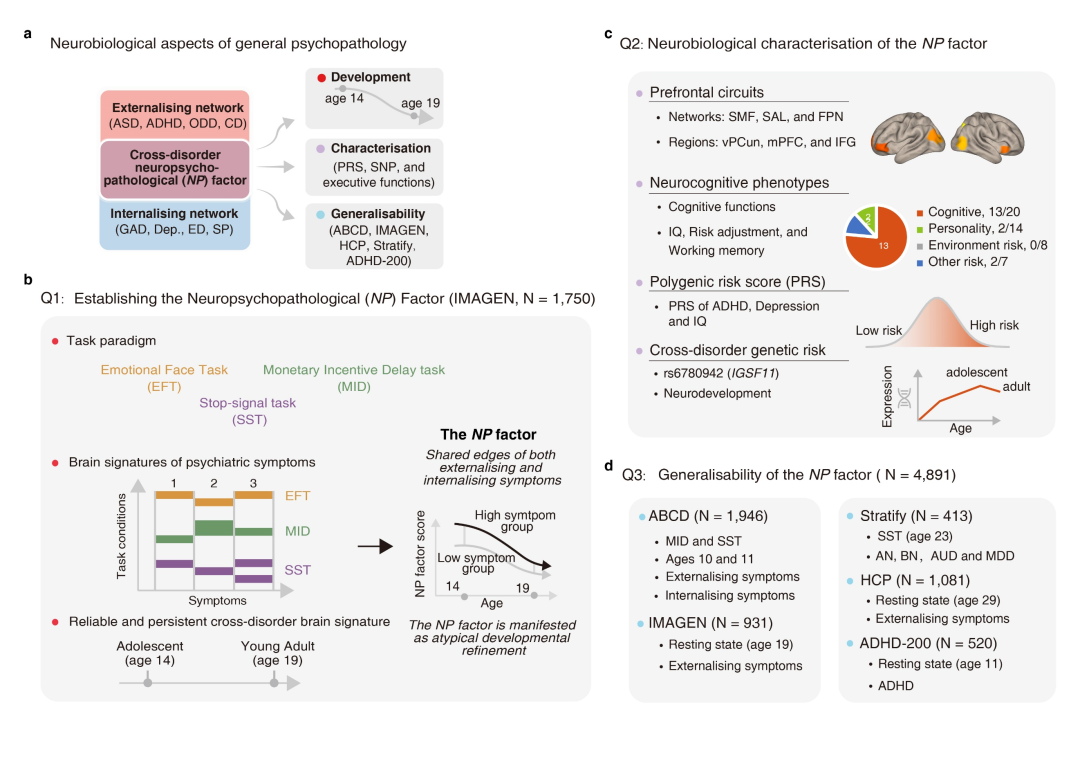According to the World Health Organization (WHO), one in seven adolescents (aged 10-19) worldwide experiences mental health disorders. Depression, anxiety and behavioral disorders, such as attention deficit hyperactivity disorder (ADHD), are among the leading causes of illness and disability among adolescents, and it’s common for adolescents to experience multiple mental health disorders.
Many mental health problems emerge during adolescence. Disorders such as depression and anxiety manifest as ‘internalizing’ symptoms, including low mood and worrying. Others, such as ADHD, manifest as ‘externalizing’ symptoms, including impulsive behaviour.
In a study published in Nature Medicine on 24 April 2023, researchers from the ISTBI identified a characteristic pattern of brain activity among these adolescents, termed as the ‘neuropsychopathological factor’, or NP factor for short.

Fig. 1: Overview of research questions and analyses
The research team examined data from the 1,750 adolescents, aged 14 years, from the IMAGEN cohort, a European research project examining how biological, psychological, and environmental factors during adolescence may influence brain development and mental health. In particular, they examined imaging data from brain scans taken while participants took part in cognitive tasks, looking for patterns of brain connectivity – in other words, how different regions of the brain communicate with each other.
Adolescents who experienced mental health problems – regardless of whether their symptoms were internalizing or externalizing, or whether they experienced multiple disorders – showed similar patterns of brain activity. These patterns (NP factor) were largely apparent in frontal lobes, the area at the front of the brain responsible for executive function, which, among other functions, controls flexible thinking, self-control and emotional behaviour.

Fig. 2: NP factor as genetic endophenotype
The researchers confirmed their findings by replicating them in 1,799 participants from the ABCD Study in the USA, a long-term study of brain development and child health, and by studying patients who had received psychiatric diagnoses.
When the team looked at genetic data from the IMAGEN cohort, they found that the NP factor was strongest in individuals who carried a particular variant of the gene IGSF11 that has been previously associated with multiple mental health disorders. This gene is known to play an important role in synaptic pruning, a process whereby unnecessary brain connections – synapses – are discarded. Problems with pruning may particularly affect the frontal lobes, since these regions are the last brain areas to complete development in adolescents and young adults.
The discovery of the NP factor could help identify young people who are at greatest risk of compounding mental health problems, enabling early intervention and risk reduction.
Full Article:
Xie, C., Xiang, S., Shen, C. et al. A shared neural basis underlying psychiatric comorbidity. Nat Med 29, 1232–1242 (2023). https://doi.org/10.1038/s41591-023-02317-4
About Our Authors:

Dr. Chao Xie (First Author)
Postdoctoral Fellow
Dr. Xie has published several articles on the topic of reinforcement-related functional circuits underlying common mental disorders, including "Differentiating the distinct roles of neural networks in adolescent depression" (BP:CNNI, 2020), "A novel dual-pathway theory of alcohol abuse in adolescents" (Science Advances, 2021), and "Identifying a shared general neural basis underlying comorbid psychopathology" (Nature Medicine, 2023).

A/Prof. Tianye Jia (Corresponding Author)
Research Professor
A/Prof. Jia is supported by the National Science Fund for Excellent Young Scientists and Shanghai Pujiang Scholarship. He previously worked at the Institute of Psychiatry, Psychology and Neuroscience of King’s College London (ranked 2nd for Psychology and Psychiatry world-wide). Jia’s study focuses on understanding the neurobiological bases for human behaviour and psychiatric disorders with large neuroimaging genetic data. Of over 50 publications, he has published articles as the first or corresponding author on flagship/top journals such as Nature Medicine, Nature Human Behaviour, PNAS, Nature Communications, Science Advances, Molecular Psychiatry, Biological Psychiatry and JAACAP.

